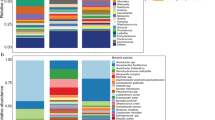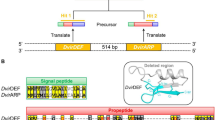Abstract
Neosporiosis, a serious disease caused by the apicomplexan intracellular parasite Neospora caninum, is considered to be one of the most economically important diseases in cattle. It is associated with potentially serious complications such as abortion, stillbirth and maternal infertility. To survive in fluctuating physiological and immunological environments, N. caninum has evolved a diverse set of regulatory mechanisms that govern various adaptive responses. The most intriguing paradigm in N. caninum adaptive evolutionary biology is its ability to alternate between two phenotypically and functionally distinct stages within the host. Recent research has reinforced the notion that N. caninum tachyzoite–bradyzoite stage switching on and off is correlated with its ability to form dormant cysts. Knowledge of the specific mechanisms that govern the dynamics of N. caninum phenotype switching enables a better understanding of the pathogenesis of the disease and effective control measures to be identified. Herein we review the available knowledge relating to various aspects of stage interconversion in N. caninum, with particular focus on the stress-related hypothesis presumed to be involved in this event. Finally, we put forward the postulation that N. caninum uses stage interconversion as an adaptive process to cope with the hostile environment within the host and to ensure its continuity in nature.

Similar content being viewed by others
References
Almeria S, Ferrer D, Pabon M, Castella J, Manas S (2002) Red foxes (Vulpes vulpes) are a natural intermediate host of Neospora caninum. Vet Parasitol 107:287–294
Anderson ML, Andrianarivo AG, Conrad PA (2000) Neosporosis in cattle. Anim Reprod Sci 60(61):417–431
Buxton D, McAllister MM, Dubey JP (2002) The comparative pathogenesis of neosporosis. Trends Parasitol 18:546–552
da Silva F, Mda F, Barbosa HS, Gross U, Luder CG (2008) Stress-related and spontaneous stage differentiation of Toxoplasma gondii. Mol Biosyst 4:824–834
Dubey JP (1999) Neosporosis—the first decade of research. Int J Parasitol 29:1485–1488
Dubey JP, Lindsay DS (1996) A review of Neospora caninum and neosporosis. Vet Parasitol 67:1–59
Dubey JP, Hattel AL, Lindsay DS, Topper MJ (1988) Neonatal Neospora caninum infection in dogs: isolation of the causative agent and experimental transmission. J Am Vet Med Assoc 193:1259–1263
Dubey JP, Barr BC, Barta JR, Bjerkas I, Bjorkman C, Blagburn BL, Bowman DD, Buxton D, Ellis JT, Gottstein B, Hemphill A, Hill DE, Howe DK, Jenkins MC, Kobayashi Y, Koudela B, Marsh AE, Mattsson JG, McAllister MM, Modry D, Omata Y, Sibley LD, Speer CA, Trees AJ, Uggla A, Upton SJ, Williams DJ, Lindsay DS (2002) Redescription of Neospora caninum and its differentiation from related coccidia. Int J Parasitol 32:929–946
Dubey JP, Schares G, Ortega-Mora LM (2007) Epidemiology and control of neosporosis and Neospora caninum. Clin Microbiol Rev 20:323–367
Fuchs N, Sonda S, Gottstein B, Hemphill A (1998) Differential expression of cell surface- and dense granule-associated Neospora caninum proteins in tachyzoites and bradyzoites. J Parasitol 84:753–758
Gondim LF, McAllister MM, Pitt WC, Zemlicka DE (2004) Coyotes (Canis latrans) are definitive hosts of Neospora caninum. Int J Parasitol 34:159–161
Hemphill A, Vonlaufen N, Naguleswaran A (2006) Cellular and immunological basis of the host–parasite relationship during infection with Neospora caninum. Parasitology 133:261–278
Innes EA, Wright SE, Maley S, Rae A, Schock A, Kirvar E, Bartley P, Hamilton C, Carey IM, Buxton D (2001) Protection against vertical transmission in bovine neosporosis. Int J Parasitol 31:1523–1534
Jardine JE (1996) The ultrastructure of bradyzoites and tissue cysts of Neospora caninum in dogs: absence of distinguishing morphological features between parasites of canine and bovine origin. Vet Parasitol 62:231–240
Kang SW, Kweon CH, Lee EH, Choe SE, Jung SC, Quyen DV (2008a) The differentiation of transcription between tachyzoites and bradyzoites of in vitro cultured Neospora caninum. Parasitol Res 103:1011–1018
Kang SW, Lee EH, Jean YH, Choe SE, Van Quyen D, Lee MS (2008b) The differential protein expression profiles and immunogenicity of tachyzoites and bradyzoites of in vitro cultured Neospora caninum. Parasitol Res 103:905–913
Kano R, Masukata Y, Omata Y, Kobayashi Y, Maeda R, Saito A (2005) Relationship between type 1/type 2 immune responses and occurrence of vertical transmission in Balb/c mice infected with Neospora caninum. Vet Parasitol 129:159–164
Lally N, Jenkins M, Liddell S, Dubey JP (1997) A dense granule protein (NCDG1) gene from Neospora caninum. Mol Biochem Parasitol 87:239–243
Lei Y, Davey M, Ellis J (2005) Autofluorescence of Toxoplasma gondii and Neospora caninum cysts in vitro. J Parasitol 91:17–23
Lyons RE, McLeod R, Roberts CW (2002) Toxoplasma gondii tachyzoite–bradyzoite interconversion. Trends Parasitol 18:198–201
McAllister MM, Parmley SF, Weiss LM, Welch YJ, McGuire AM (1996) An immunohistochemical method for detecting bradyzoite antigen (BAG5) in Toxoplasma gondii-infected tissues cross-reacts with a Neospora caninum bradyzoite antigen. J Parasitol 82:354–355
Pérez-Zaballos FJ, Ortega-Mora LM, Alvarez-García G, Collantes-Fernández E, Navarro-Lozano V, García-Villada L, Costas E (2005) Adaptation of Neospora caninum isolates to cell-culture changes: an argument in favor of its clonal population structure. J Parasitol 91:507–510
Quinn HE, Ellis JT, Smith NC (2002) Neospora caninum: a cause of immune-mediated failure of pregnancy? Trends Parasitol 18:391–394
Risco-Castillo V, Fernandez-Garcia A, Ortega-Mora LM (2004) Comparative analysis of stress agents in a simplified in vitro system of Neospora caninum bradyzoite production. J Parasitol 90:466–470
Schwan TG, Hinnebush BJ (1998) Bloodstream- versus tick-associated variants of a relapsing fever bacterium. Science 280:1938–1940
Speer CA, Dubey JP, McAllister MM, Blixt JA (1999) Comparative ultrastructure of tachyzoites, bradyzoites, and tissue cysts of Neospora caninum and Toxoplasma gondii. Int J Parasitol 29:1509–1519
Tunev SS, McAllister MM, Anderson-Sprecher RC, Weiss LM (2002) Neospora caninum in vitro: evidence that the destiny of a parasitophorous vacuole depends on the phenotype of the progenitor zoite. J Parasitol 88:1095–1099
Vonlaufen N, Muller N, Keller N, Naguleswaran A, Bohne W, McAllister MM, Bjorkman C, Muller E, Caldelari R, Hemphill A (2002) Exogenous nitric oxide triggers Neospora caninum tachyzoite-to-bradyzoite stage conversion in murine epidermal keratinocyte cell cultures. Int J Parasitol 32:1253–1265
Vonlaufen N, Guetg N, Naguleswaran A, Muller N, Bjorkman C, Schares G, von Blumroeder D, Ellis J, Hemphill A (2004) In vitro induction of Neospora caninum bradyzoites in vero cells reveals differential antigen expression, localization, and host-cell recognition of tachyzoites and bradyzoites. Infect Immun 72:576–583
Weiss LM, Ma YF, Halonen S, McAllister MM, Zhang YW (1999) The in vitro development of Neospora caninum bradyzoites. Int J Parasitol 29:1713–1723
Williams DJ, Trees AJ (2006) Protecting babies: vaccine strategies to prevent foetopathy in Neospora-infected cattle. Parasite Immunol 28:61–67
Acknowledgements
The authors acknowledge the financial support of The Royal College of Veterinary Surgeons (RCVS) Trust (grant no. RB3808) to H.E.
Author information
Authors and Affiliations
Corresponding author
Rights and permissions
About this article
Cite this article
Eastick, F.A., Elsheikha, H.M. Stress-driven stage transformation of Neospora caninum . Parasitol Res 106, 1009–1014 (2010). https://doi.org/10.1007/s00436-010-1788-z
Received:
Accepted:
Published:
Issue Date:
DOI: https://doi.org/10.1007/s00436-010-1788-z




